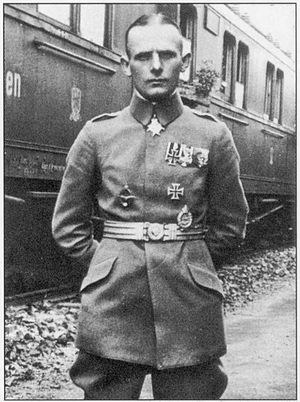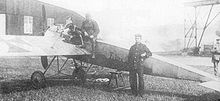- Otto Parschau
-
Otto Parschau 
Photo of Leutnant Otto Parschau just after earning the Pour le MériteBorn 11 November 1890
Klutznick, Allenstein, East PrussiaDied 21 July 1916
Grévillers, FranceAllegiance German Empire Service/branch Luftstreitkräfte Years of service 1910-1916 Rank Leutnant Unit FFA 42, FFA 261, FFA 32 Commands held Abwehrkommando Nord Awards Pour le Mérite, Royal House Order of Hohenzollern, Iron Cross 2nd Class Leutnant Otto Parschau (11 November 1890 - 21 July 1916) was a German World War I Flying Ace and recipient of the Pour le Mérite, Royal House Order of Hohenzollern, and Iron Cross, First Class. He was noted as one of the pre-eminent aces on the Fokker Eindecker. He was one of the world's first flying aces, as along with Leutnant Kurt Wintgens, Parschau was one of the original pilots entrusted with the revolutionary fighter plane with a machine gun synchronized to fire safely through its propeller arc via use of an interrupter gear.[1]
Contents
Background
Parschau was born in Klutznitz, in the Allenstein district of East Prussia. He became a commissioned officer a year after having joined the Infanterie-Regiment Nr. 151 in 1910. Parschau was trained as a pilot in Johannisthal, Darmstadt and in Hanover and received his licence on 4 July 1913.[2]
Involvement in 1st World War
At the outbreak of war, Parschau was already serving in the Luftstreitkräfte flying two seaters in operations on the Champagne war front and then in Flanders and Alsace-Lorraine before being posted to West Prussia and Galicia, on the Eastern Front.[2]
The Green Machine (A.16/15)
Parschau was assigned a Fokker Eindecker M 5L aircraft, previously used by Oberleutnant von Buttlar. This officer's unit (the Marburg Jager regiment) had green as its regimental colours. The aircraft being painted accordingly, became distinctive as Parschau's 'Green Machine', right from the outbreak of World War I. Parschau flew this machine on a roving commission for nearly a year, serving with FFAs 22 and 42 and the Brieftauben-Abteilung Ostende messenger pigeon-designated unit, which was actually a group of four FFA units operating as one for the Oberste Heeresleitung or OHL, the World War I German Army's High Command office. In this period, Parschau flew his distinctive machine on the Champagne front during October and November 1914. Following this were periods in Flanders and Alsace-Lorraine before Parschau was posted first to West Prussia and then on to Galicia on the Eastern Front. His travels were marked on the Fokker's fuselage.[2]
 Otto Parschau's Fokker M.5K/MG with IdFlieg serisl E.1/15, the very first series-built Fokker Eindecker ever produced, shown with "lowered" wing mount location.
Otto Parschau's Fokker M.5K/MG with IdFlieg serisl E.1/15, the very first series-built Fokker Eindecker ever produced, shown with "lowered" wing mount location.
Later war service
Because Parschau was recognised as an experienced and proficient pilot, he was selected to go to FFA 62 at Douai as an instructor on monoplanes. Amongst his students at FFA 62 were the notable pioneer German flying aces, Max Immelmann and Oswald Boelcke.[2] Despite his earlier complaints of his Parabellum machine gun jamming, he managed to reel off a string of six victories over enemy airplanes between 11 October 1915 and 2 July 1916 as part of the Fokker Scourge. On 3 July 1916, he shot down an enemy observation balloon. In July 1916 he transferred to FFA 32, gaining his 8th victory on 9 July 1916.[3] He was awarded the Pour le Merite the following day.[4] On the 14th, AKN was severed from FFA 32 and Parschau was appointed to its command.[5]
On 21 July Parschau was mortally wounded during combat with the RFC over Grévillers.[3] He was severely wounded in the chest and also suffered a glancing bullet wound to the head. Somehow, he retained enough control to land his plane behind German lines. He was rushed to a field surgery station but died on the operating table.[6]
Notes
- ^ Early German Aces of World War I. pp. 4, 9.
- ^ a b c d Early German Aces of World War I. p. 9.
- ^ a b Above the Lines: The Aces and Fighter Units of the German Air Service, Naval Air Service and Flanders Marine Corps 1914 - 1918. p. 138.
- ^ http://www.pourlemerite.org/ Retrieved on 26 April 2010.
- ^ Early German Aces of World War I. p. 64.
- ^ Early German Aces of World War I. p. 66.
References
- van Wyngarden, G. Early German Aces of World War 1. Oxford: Osprey Publishing, 2006. ISBN 1-84176-997-5.
- Grosz, Peter M., Windsock Datafile No. 91, Fokker E.I/II, Albatros Publications, Ltd. 2002. ISBN No. 1-902207-46-7.
- Franks, Norman L. R., et al., Above the Lines: The Aces and Fighter Units of the German Air Service, Naval Air Service and Flanders Marine Corps 1914 - 1918 Grub Street, 1993. ISBN 0948817739, 9780948817731.
People and aircraft Campaigns and battles Strategic bombing (German, Cuxhaven) · Bombing of cities · Fokker Scourge · Flight over Vienna · Bloody April · BattlesEntente Powers air services Australian Flying Corps · British air services (Royal Flying Corps, Royal Naval Air Service, Royal Air Force) · French Air Service · Imperial Russian Air Force · Italian Military Air Corps · United States Army Air Service · Greek air services (Army Air Service, Naval Air Service)Central Powers air services German air services (Army Air Service, Navy Air Service) · Austro-Hungarian Imperial and Royal Aviation Troops · Ottoman Air Force · Bulgarian Army Aeroplane SectionCategories:- German military personnel of World War I
- German World War I flying aces
- Luftstreitkräfte personnel
- Recipients of the Iron Cross
- Aviators killed in aviation accidents or incidents in France
- German military personnel killed in World War I
- Recipients of the Pour le Mérite (military class)
- Recipients of the House Order of Hohenzollern
- 1890 births
- 1916 deaths
Wikimedia Foundation. 2010.
